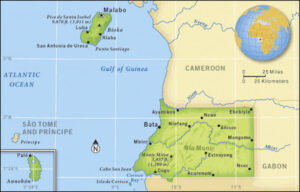Africa, with its rich cultural diversity and complex history, is home to several countries with names that may sound familiar yet distinct. From shared linguistic roots to historical influences, these nations offer a fascinating glimpse into the interconnectedness of the continent.
In this article, we delve into the intriguing world of African countries with similar or identical names, uncovering their unique identities, histories, and contributions to the African tapestry.
- Guinea and Equatorial Guinea:

- At first glance, Guinea and Equatorial Guinea may appear to be the same country, but they are distinct entities with their own stories. Guinea, officially known as the Republic of Guinea, is located in West Africa and gained independence from France in 1958. It is renowned for its vibrant culture, diverse landscapes, and significant mineral resources, including bauxite and gold.
On the other hand, Equatorial Guinea, situated in Central Africa, comprises a mainland region and several islands. Formerly a Spanish colony, it achieved independence in 1968. Despite its small size, Equatorial Guinea boasts substantial oil reserves, which have contributed to its economic growth. Both countries share a name derived from the Gulf of Guinea, which lies along Africa’s western coast.
- Congo and Democratic Republic of the Congo:

- The names Congo and Democratic Republic of the Congo often evoke images of lush rainforests and the mighty Congo River. However, these neighboring nations have distinct historical trajectories and cultural landscapes. The Republic of the Congo, also known as Congo-Brazzaville, gained independence from France in 1960. It is celebrated for its biodiversity, including the iconic Congo Basin rainforest.
In contrast, the Democratic Republic of the Congo (DRC) is Africa’s second-largest country by land area and is situated in Central Africa. Formerly known as Zaire, it obtained independence from Belgium in 1960. Despite its abundant natural resources, including copper and cobalt, the DRC has faced numerous challenges, including political instability and conflict. The shared name reflects their geographical proximity and historical ties to the Congo River basin.
- Sudan and South Sudan:

- Sudan and South Sudan, two nations in Northeast Africa, share a name rooted in their geographical location along the Nile River. Sudan, officially known as the Republic of the Sudan, is the larger of the two countries and gained independence from Britain and Egypt in 1956. It is known for its diverse cultural heritage, ancient archaeological sites, and vast deserts.
Also, read: Ethiopia Launches Repatriation of 70,000 Nationals Stranded in Saudi Arabia
In contrast, South Sudan, the world’s newest country, declared independence from Sudan in 2011 after decades of civil war. Despite its status as a fledgling nation, South Sudan is rich in natural resources, including oil reserves. However, it continues to grapple with internal conflict and humanitarian challenges. The shared name underscores their historical ties while marking their distinct paths to nationhood.
- Niger and Nigeria:

- Niger and Nigeria, neighboring countries in West Africa, share a name derived from the Niger River, which flows through both nations. Niger, officially known as the Republic of Niger, gained independence from France in 1960. It is characterized by its vast desert landscapes, including the iconic Sahara Desert, and is one of the world’s poorest countries.
In contrast, Nigeria, often referred to as the “Giant of Africa,” is the continent’s most populous country and largest economy. It gained independence from Britain in 1960 and is renowned for its cultural diversity, vibrant cities, and significant oil reserves. Despite their differing economic profiles, Niger and Nigeria share a name that reflects their geographical connection and historical ties to the Niger River basin.
Conclusion:
African countries with similar or identical names offer a glimpse into the continent’s diverse tapestry of cultures, histories, and landscapes. From Guinea and Equatorial Guinea to Sudan and South Sudan, these nations share linguistic and geographical connections while embodying unique identities and trajectories. Exploring their stories enriches our understanding of Africa’s rich heritage and the complexities of its modern-day realities.

